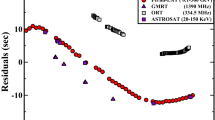Abstract
One of the most remarkable properties of radio pulsars is their rotational stability which allows many uses as clocks, For instance they enable us to determine the shapes and sizes of binary orbits, to study general relativistic effects in strong gravitational fields, to demonstrate the existance of gravitational radiation from binary systems, to permit the detection of extra solar planets, and also to put limits on the long period gravitational wave background. However, some display timing imperfections which tell us about the insides of neutron stars. This review describes the basic physics of slowdown and how period instabilities seem to be related to the rate of slowdown and the presence of internal superfluid liquid. Careful studies of glitches and the subsequent rotational behaviour of the pulsars can provide valuable information on the internal structure of neutron stars.
Similar content being viewed by others
References
Alpar M. A., Chau H. F., Cheng K. S., Pines D., 1993, ApJ, 409, 345
Anderson P. W., Itoh N., 1975, Nat, 256, 25
Arzoumanian Z., Nice D. J., Taylor J. H., Thorsett S. E., 1994, ApJ, 422, 671
Backus P. R., Taylor J. H., Damashek M., 1982, ApJ, 255, L63
Baym G., Pethick C., Pines D., 1969, Nat, 224, 673
Baym G., Pethick C., Pines D., Ruderman M., 1969, Nat, 224, 872
Boynton P. E., Groth E. J., Hutchinson D. P., Nanos G. P., Partridge R. B., Wilkinson D. T., 1972, ApJ, 175, 217
Clifton T. R., Lyne A. G., 1986, Nat, 320, 43
Clifton T. R., Lyne A. G., Jones A. W., McKenna J., Ashworth M., 1992, MNRAS, 254, 177
Cordes J. M., Downs G. S., 1985, ApJS, 59, 343
Cordes J. M., Helfand D. J., 1980, ApJ, 239, 640
Cordes J. M., Downs G. S., Krause-Polstorff J., 1988, ApJ, 330, 847
Downs G. S., 1982, ApJ, 257, L67
Flanagan C. S., 1989. LAU Circ. No. 4695
Flanagan C. S., 1991. IAU Circ. No. 5311
Goldreich P., Julian W. H., 1969, ApJ, 157, 869
Gullahorn G. E., Payne R. R., Rankin. J. M., Richards D. W., 1976, ApJ, 205, L151
Johnston S., Lyne A. G., Manchester R. N., Kniffen D. A., D’Amico N., Lim J., Ashworth M., 1992a, MNRAS, 255, 401
Johnston S., Manchester R. N., Lyne A. G., Bailes M., Kaspi V. M., Qiao G., D’Amico N., 1992b, ApJ, 387, L37
Kaspi V. M., Manchester R. N., Johnston S., Lyne A. G., D’Amico N., 1992, ApJ, 399, L155
Kaspi V. M., Lyne A. G., Manchester R. N., Johnston S., D’Amico N., Shemar S. L., 1993, ApJ, 409, L57
Kaspi V. M., Manchester R. N., Siegman B., Johnston S., Lyne A. G., 1994, ApJ, 422, L83
Lohsen E., 1975, Nat, 258, 688
Lyne A. G., Pritchard R. S., 1987, MNRAS, 229, 223
Lyne A. G., Pritchard R. S., Graham-Smith F., 1992, Nat, 359, 706
Lyne A. G., Pritchard R. S., Graham-Smith F., 1993, MNRAS, 265, 1003
Lyne A. G., Pritchard R. S., Smith F. G., 1988, MNRAS, 233, 667
Lyne A. G., 1987, Nat, 326, 569
Lyne A. G., 1992, Phil. Trans. Roy. Soc. A, 341, 29
Manchester R. N., Peterson B. A., 1989, ApJ, 342, L23
Manchester R. N., Taylor J. H., 1974, ApJ, 191, L63
Manchester R. N., Goss W. M., Hamilton P. A., 1976, Nat, 259, 291
Manchester R. N., Newton L. M., Goss W. M., Hamilton P. A., 1978, MNRAS, 184, 35P
Manchester R. N., Newton L. M., Hamilton P. A., Goss W. M., 1983, MNRAS, 202, 269
McCulloch P. M., Hamilton P. A., Royle G. W. R., Manchester R. N., 1983, Nat, 302, 319
McCulloch P. M., Klekociuk A. R., Hamilton P. A., Royle G. W. R., 1987, Aust. J. Phys., 40, 725
McCulloch P. M., Hamilton P. A., McConnell D., King E. A., 1990, Nat, 346, 822
McKenna J., Lyne A. G., 1990, Nat, 343, 349
Newton L. M., Manchester R. N., Cooke D. J., 1981, MNRAS, 194, 841
Pines D., Shaham J., Ruderman M. A., 1972, Nature Phys. Sci., 237, 83
Pines D., 1991, in Ventura J., Pines D., eds, Neutron Stars: Theory and Observation. Kluwer Academic Publishers, p. 57
Radhakrishnan V., Manchester R. N., 1969, Nat, 222, 228
Reichley P. E., Downs G. S., 1971, Nature Phys. Sci., 234, 48
Shemar S. L., Lyne A. G. 1995. in preparation
Author information
Authors and Affiliations
Rights and permissions
About this article
Cite this article
Lyne, A.G., Pritchard, R.S. & Shemar, S.L. Timing noise and glitches. J Astrophys Astron 16, 179–190 (1995). https://doi.org/10.1007/BF02714833
Issue Date:
DOI: https://doi.org/10.1007/BF02714833




